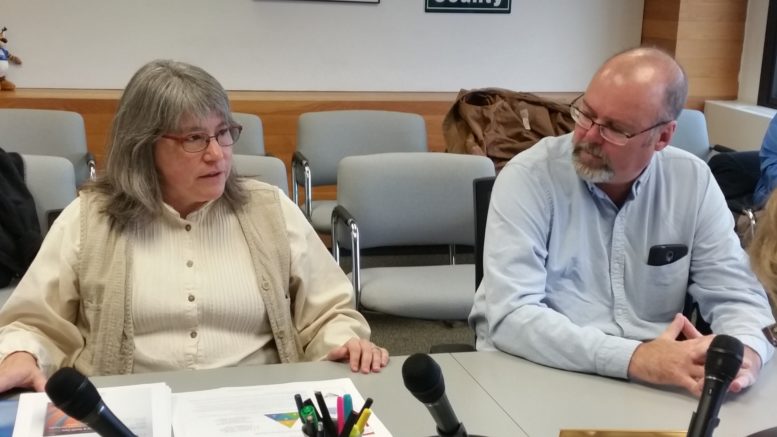By JAN LARSON McLAUGHLIN
BG Independent News
Traumatized kids aren’t likely to open up and spill their stories to a stranger sitting behind a desk. But nearly all types of therapy – even for children – are cognitive. They require kids to think about the trauma.
“Kids are not ready to think about it. It feels so icky,” said Bobbi Beale, chief executive officer of an adventure therapy program near Cleveland. “It’s hard. It’s uncomfortable for them.”
So Beale bypasses the cognitive block in traumatized kids and takes the therapy to their level. In adventure therapy, the child is not a spectator. Through games, problem solving and adventure activities, children are allowed to regain some control over their behaviors and emotions.
Beale presented the basics of adventure therapy to the Wood County Commissioners on Tuesday, along with Dave Wigent, director of Wood County Job and Family Services. Wigent explained that some Wood County Children’s Services staff are being trained in the program.
According to Beale, one-third to one-half of all children have experienced some type of trauma that disrupts their functioning at some point. Adventure therapy engages them and allows them to feel safe – so they can then deal with the trauma.
The therapy focuses on strengths – not what the child is doing wrong, but how resilient they are. Adventure therapy allows the child to practice positive behaviors, Beale said. It’s those rehearsals that help the child call upon those skills when needed outside of therapy.
This type of therapy promotes a feeling of safety and attachment to others in group therapy. Children who have felt isolated from others become part of positive peer groups.
It allows children to get control over their bodies and emotions. And since adventure therapy can be enjoyable and rewarding, it has a better chance of children completing the program, Beale said.
So many traumatized children have gaps in their learning, she explained. They may be so focused on survival, that they cannot use their energy for classroom learning. They live in a constant state of “high alert,” which doesn’t leave room for much else. While small gaps in learning can be filled in later, longer trauma creates bigger gaps that become bigger problems as they age.
The idea behind adventure therapy is that children are resilient.
“Resiliency is the idea that people can come back from bad things,” Beale said. They can not only survive, but can thrive, she added.
Adventure therapy also gives kids a chance to make a difference in their communities by doing projects like a river cleanup or helping at a soup kitchen. “It takes them out of their victim status.”
Wigent said the program already has a partnership with Children’s Resource Center, with two groups of youths currently participating in the therapy.
“It’s a good solid start,” Wigent said.
By February or March, Wigent is hoping the adventure therapy can be offered to youth involved in Children’s Services. The program will have a research component, so the outcomes for the youths can be tracked.
“So much of what we do is coming in after the fact and picking up the pieces,” he said.
Seven or eight other counties in Ohio are interested in Wood County’s efforts to adopt adventure therapy. Expansion may mean the program could secure some grant funding, Wigent said.
“We’re really gaining some momentum with it,” he said.
“If we could get a little more attention and funding, we could reach more kids,” Beale said.
Ultimately, Beale hopes the adventure therapy research shows a decrease in problem behaviors, an increase in social skills, and the ability of children to achieve goals in the future rather than just surviving in the present.
“We hope to spark that,” she said.
Wigent hopes to offer the adventure therapy to foster children in the county, especially those aging out of the system.
“We’ve absolutely got to do more for kids exiting care,” he said.
Beale agreed that foster care population is particularly vulnerable. “If you don’t have a family behind you, holding you up,” then temporary stumbles can be permanent downfalls without some support, she said.

